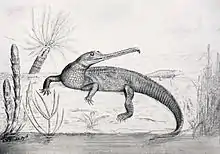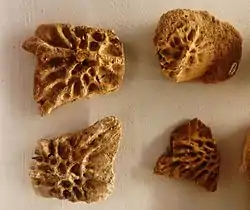Mystriosuchus
Mystriosuchus (meaning "spoon-crocodile")[1] is an extinct genus of phytosaur that lived in the Late Triassic (middle Norian) in Europe. It was first named by Eberhard Fraas in 1896, and includes three species: M. westphali, M. steinbergeri and the type species, M. planirostris.[2]
| Mystriosuchus Temporal range: Upper Triassic | |
|---|---|
 | |
| Skull of M. planirostris | |
| Scientific classification | |
| Kingdom: | Animalia |
| Phylum: | Chordata |
| Class: | Reptilia |
| Order: | †Phytosauria |
| Family: | †Phytosauridae |
| Subfamily: | †Pseudopalatinae |
| Genus: | †Mystriosuchus Fraas, 1896 |
| Species | |
Description

Mystriosuchus planirostris measured about 4 m (13 ft), according to a complete skeleton which was found in 1995.[3] The postcranial anatomy of the skeleton suggests that Mystriosuchus was more adapted to aquatic life than other known phytosaurs, possessing shorter and more paddle-like limbs as well as just two type of osteoderms as opposed to the higher diversity of other phytosaurs.[3] Cranial morphology is suggestive of a primarily fish eating diet, having long jaws like those of the modern gharials.[2] Several specimens have been recovered from marine fossil sites.[3] [4] A study on phytosaur microwear shows a prefference towards softer invertebrates.[5]
M. planirostris, as the name implies, has a rather "plain" snout, without osseous ornamentation or crests. M. westphali, on the other hand, has multiple bony crests along the upper jaw, most prominently at the base and tip of the snout. As keratinous crests are known in phytosaurs,[6] it is possible that M. planirostris had soft tissue ornamentation.
Vertebrae

Mystriosuchus possesses many vertebrae, with 25 in the neck and torso, two in the pelvis, and 74 in the tail. The vertebral column is complete and nearly all articulated, although a portion of the tail can only be seen from top view. The vertebrae behind the axis vertebra are platycoelous (one surface flat and one concave), and are approximately rectangular in shape. Because of incomplete preservation, it can't be distinguished where the neck meets the torso, although at least 17 of the 25 vertebrae come from the latter. The trunk vertebrae are lower and wider than the neck vertebrae, but are still lightly built. The pelvic vertebrae have wide ribs which attach to the ilium (largest pelvis bone). The tail is longer than the rest of the body, being 51% of the total length of the taxon. The first 17 vertebrae of the tail are similar to those of the neck and trunk, being platycoelous and subrectangular. Chevrons are present after the fourth vertebra, but are only loosely attached for the beginning of the tail. At the end of the tail the vertebrae become more slanted, and the chevrons form an inverted 'T' shape, which is not seen in other phytosaurs but in sauropterygians or some crocodilians.[3]
Classification

Mystriosuchus used to be placed in its own subfamily, Mystriosuchidae,[7][8] but subsequent cladistic analysis grouped it with other members of Pseudopalatinae, despite having several physical differences from most of the genera in this group.[2] Originally considered to be a freshwater genus, a recent specimen from Northern Italy has shown that some Mystriosuchus specimens lived a completely marine life.[9] In their paper on Parasuchus, Christian Kammerer and colleagues noted that Mystriosuchini has priority over Pseudopalatinae, so synonymized Pseudopalatinae with Mystriosuchini.[10]
Below is a cladogram from Stocker (2012):[11]
| Phytosauria |
| |||||||||||||||||||||||||||||||||||||||||||||||||||||||||||||||||||||||||||||||||||||||||||||
References
- dipbsf.uninsubria.it Mystriosuchus planirostris description Retrieved on May 25th, 2008.
- Hungerbühler, A. 2002. The Late Triassic phylosaur Mystriosuchus westphali, with a revision of the genus. Palaeontology 45(2): 377-418.
- Gozzi, E.; Renesto, S.A. (2003). "Complete specimen of Mystriosuchus (Reptilia, Phytosauria) from the Norian (Late Triassic) of Lombardy (Northern Italy)". Rivista Italiana di Paleontologia e Stratigrafia. 109 (3): 475–498.
- https://academic.oup.com/zoolinnean/article-abstract/187/1/198/5487160?redirectedFrom=fulltext
- https://onlinelibrary.wiley.com/doi/10.1111/pala.12515
- Stocker, M. R. & Butler, R. J. 2013. Phytosauria. Geological Society, London, Special Publications 379, 91-117.
- von Huene, F. 1915. On reptiles of the New Mexican Trias in the Cope Collection. Bulletin of the American Museum of Natural History 34: 485-507.
- Long, R.A. & Murry, P.A. 1995. Late Triassic (Carnian and Norian) tetrapods from the southwestern United States. Bulletin of the New Mexico Museum of Natural History and Science 4 254 pp.
- Gozzi, E. & Renesto, S.A. 2003. Complete specimen of Mystriosuchus (Reptilia, Phytosauria) from the Norian (Late Triassic) of Lombardy (Northern Italy). Rivista Italiana Di Paleontologia e Stratigrafia 109(3): 475-498.
- Kammerer, C. F., Butler, R. J., Bandyopadhyay, S., Stocker, M. R. (2016), Relationships of the Indian phytosaur Parasuchus hislopi Lydekker, 1885. Papers in Palaeontology, 2: 1–23. doi: 10.1002/spp2.1022 http://onlinelibrary.wiley.com/doi/10.1002/spp2.1022/abstract
- Stocker, M. R. (2012). "A new phytosaur (Archosauriformes, Phytosauria) from the Lot's Wife beds (Sonsela Member) within the Chinle Formation (Upper Triassic) of Petrified Forest National Park, Arizona". Journal of Vertebrate Paleontology. 32 (3): 573–586. doi:10.1080/02724634.2012.649815.







